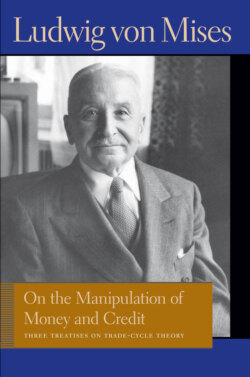Читать книгу On the Manipulation of Money and Credit - Людвиг фон Мизес - Страница 6
На сайте Литреса книга снята с продажи.
CONTENTS
ОглавлениеForeword
STABILIZATION OF THE MONETARY UNIT—FROM THE VIEWPOINT OF THEORY (1923)
Introduction
CHAPTER I The Outcome of Inflation
1 Monetary Depreciation
2 Undesired Consequences
3 Effect on Interest Rates
4 The Run from Money
5 Effect of Speculation
6 Final Phases
7 Greater Importance of Money to a Modern Economy
CHAPTER II The Emancipation of Monetary Value from the Influence of Government
1 Stop Presses and Credit Expansion
2 Relationship of Monetary Unit to World Money—Gold
3 Trend of Depreciation
CHAPTER III The Return to Gold
1 Eminence of Gold
2 Sufficiency of Available Gold
CHAPTER IV The Money Relation
1 Victory and Inflation
2 Establishing Gold “Ratio”
CHAPTER V Comments on the “Balance of Payments” Doctrine
1 Refined Quantity Theory of Money
2 Purchasing Power Parity
3 Foreign Exchange Rates
4 Foreign Exchange Regulations
CHAPTER VI The Inflationist Argument
1 Substitute for Taxes
2 Financing Unpopular Expenditures
3 War Reparations
4 The Alternatives
5 The Government’s Dilemma
CHAPTER VII The New Monetary System
1 First Steps
2 Market Interest Rates
CHAPTER VIII The Ideological Meaning of Reform
1 The Ideological Conflict
Appendix. Balance of Payments and Foreign Exchange Rates
MONETARY STABILIZATION AND CYCLICAL POLICY (1928)
Preface
PART I Stabilization of the Purchasing Power of the Monetary Unit
CHAPTER I The Problem
1 “Stable Value” Money
2 Recent Proposals
CHAPTER II The Gold Standard
1 The Demand for Money
2 Economizing on Money
3 Interest on “Idle” Reserves
4 Gold Still Money
CHAPTER III The “Manipulation” of the Gold Standard
1 Monetary Policy and Purchasing Power of Gold
2 Changes in Purchasing Power of Gold
CHAPTER IV “Measuring” Changes in the Purchasing Power of the Monetary Unit
1 Imaginary Constructions
2 Index Numbers
CHAPTER V Fisher’s Stabilization Plan
1 Political Problem
2 Multiple Commodity Standard
3 Price Premium
4 Changes in Wealth and Income
5 Uncompensatable Changes
CHAPTER VI Goods-induced and Cash-induced Changes in the Purchasing Power of the Monetary Unit
1 The Inherent Instability of Market Ratios
2 The Misplaced Partiality to Debtors
CHAPTER VII The Goal of Monetary Policy
1 Liberalism and the Gold Standard
2 “Pure” Gold Standard Disregarded
3 The Index Standard
PART II Cyclical Policy to Eliminate Economic Fluctuations
CHAPTER I Stabilization of the Purchasing Power of the Monetary Unit and Elimination of the Trade Cycle
1 Currency School’s Contribution
2 Early Trade Cycle Theories
3 The Circulation Credit Theory
CHAPTER II Circulation Credit Theory
1 The Banking School Fallacy
2 Early Effects of Credit Expansion
3 Inevitable Effects of Credit Expansion on Interest Rates
4 The Price Premium
5 Malinvestment of Available Capital Goods
6 “Forced Savings”
7 A Habit-forming Policy
8 The Inevitable Crisis and Cycle
CHAPTER III The Reappearance of Cycles
1 Metallic Standard Fluctuations
2 Infrequent Recurrences of Paper Money Inflations
3 The Cyclical Process of Credit Expansions
4 The Mania for Lower Interest Rates
5 Free Banking
6 Government Intervention in Banking
7 Intervention No Remedy
CHAPTER IV The Crisis Policy of the Currency School
1 The Inadequacy of the Currency School
2 “Booms” Favored
CHAPTER V Modern Cyclical Policy
1 Pre–World War I Policy
2 Post–World War I Policies
3 Empirical Studies
4 Arbitrary Political Decisions
5 Sound Theory Essential
CHAPTER VI Control of the Money Market
1 International Competition or Cooperation
2 “Boom” Promotion Problems
3 Drive for Tighter Controls
CHAPTER VII Business Forecasting for Cyclical Policy and the Businessman
1 Contributions of Business Cycle Research
2 Difficulties of Precise Prediction
CHAPTER VIII The Aims and Method of Cyclical Policy
1 Revised Currency School Theory
2 “Price Level” Stabilization
3 International Complications
4 The Future
THE CAUSES OF THE ECONOMIC CRISIS (1931)
CHAPTER I The Nature and Role of the Market
1 The Marxian “Anarchy of Production” Myth
2 The Role and Rule of Consumers
3 Production for Consumption
4 The Perniciousness of a “Producers’ Policy”
CHAPTER II Cyclical Changes in Business Conditions
1 Role of Interest Rates
2 The Sequel of Credit Expansion
CHAPTER III The Present Crisis
A. Unemployment
1 The Market Wage Rate Process
2 The Labor Union Wage Rate Concept
3 The Cause of Unemployment
4 The Remedy for Mass Unemployment
5 The Effects of Government Intervention
6 The Process of Progress
B. Price Declines and Price Supports
1 The Subsidization of Surpluses
2 The Need for Readjustments
C. Tax Policy
1 The Anti-capitalistic Mentality
D. Gold Production
1 The Decline in Prices
2 Inflation as a “Remedy”
CHAPTER IV Is There a Way Out?
1 The Cause of Our Difficulties
2 The Unwanted Solution
THE CURRENT STATUS OF BUSINESS CYCLE RESEARCH AND ITS PROSPECTS FOR THE IMMEDIATE FUTURE (1933)
1 The Acceptance of the Circulation Credit Theory of Business Cycles
2 The Popularity of Low Interest Rates
3 The Popularity of Labor Union Policy
4 The Effect of Lower than Unhampered Market Interest Rates
5 The Questionable Fear of Declining Prices
THE TRADE CYCLE AND CREDIT EXPANSION: THE ECONOMIC CONSEQUENCES OF CHEAP MONEY (1946)
1 Introductory Remarks
2 The Unpopularity of Interest
3 The Two Classes of Credit
4 The Function of Prices, Wage Rates and Interest Rates
5 The Effects of Politically Lowered Interest Rates
6 The Inevitable Ending
Index
